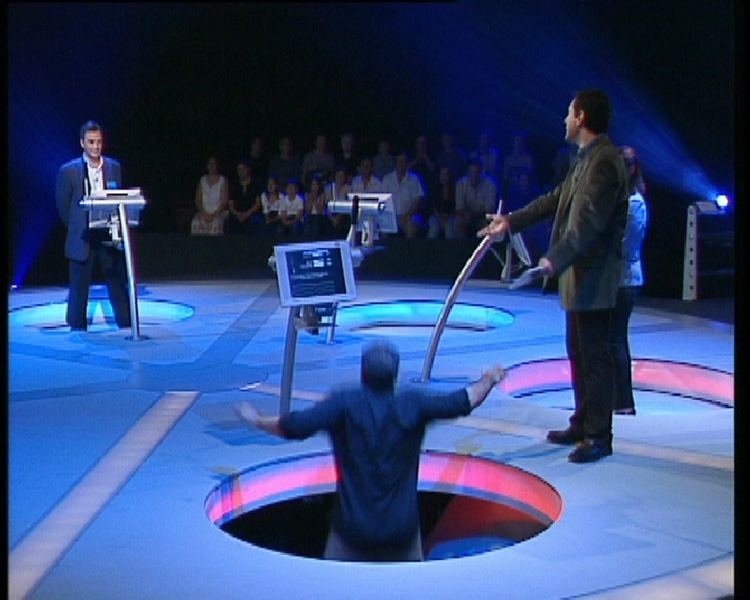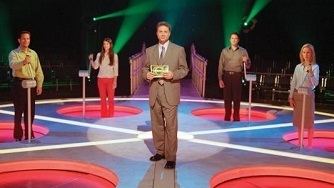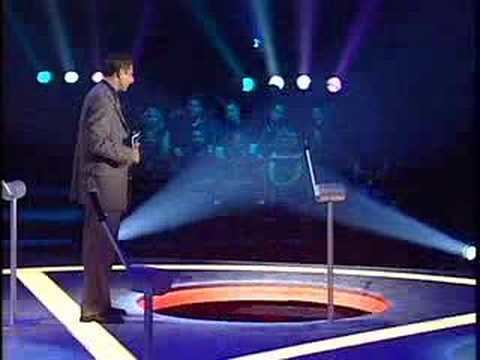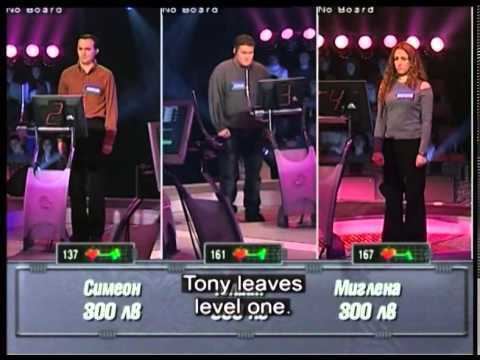7 /10 1 Votes
7/10 TV No. of seasons 2 First episode date 3 June 2002 Number of episodes 131 | 7.1/10 IMDb Created by Gunnar Wetterberg Country of origin United States No. of episodes 131 Final episode date 13 June 2003 Number of seasons 2 | |||||||||||||||||||||||||||||||||
 | ||||||||||||||||||||||||||||||||||
Location(s) Sony Pictures StudiosCulver City, California Similar Lingo, Idiotest, Mind of a Man, Catch 21, Hollywood Showdown | ||||||||||||||||||||||||||||||||||
Shocking russian roulette reality game show
Russian Roulette is an American game show created by executive producer Gunnar Wetterberg that ran for two seasons on Game Show Network from June 3, 2002 to June 13, 2003.
Contents
- Shocking russian roulette reality game show
- Russian roulette game show usa drop montage 1
- Gameplay
- First round
- Second and third rounds
- First season
- Second season
- Russian Roulette
- International versions
- References

Russian roulette game show usa drop montage 1
Gameplay

The Russian Roulette set consists of a circle with six trapdoors (referred to as "drop zones" by the host), four of which are occupied by the episode's contestants.
First round

The four contestants are each given $150 at the beginning of the episode, and questions in the first round are all worth that same amount.

The number of red lights on the field indicates the number of active drop zones. At the start of the round there is only one drop zone active. After each additional question, another drop zone is added, increasing the odds that the contestant will be eliminated after providing an incorrect answer. From the fifth question onward, there are always five drop zones.

One contestant is shown a question and must challenge an opponent to answer it. The challengee is then shown three possible answers and has 10 seconds to choose the right answer. If they are correct, that contestant wins $150 and becomes the challenger for the next question. If they guess incorrectly, they lose all their money to the challenger and must play Russian Roulette by pulling the handle in front of them to rotate the drop zones in play around the six trapdoors. If a drop zone lands on that contestant's spot, the trapdoor opens and they drop through the floor and are eliminated from the game; otherwise, they remain in the game and becomes the challenger for the next question.

The round ends when a contestant drops and is eliminated. If time expires before this happens, one contestant is eliminated at random via one final handle pull at the center of the stage. The contestant with the highest score is granted immunity from the drop by coming to the center of the stage to pull the handle. If there is a tie for the lead, host Walberg pulls the lever himself, with all four contestants in danger of elimination. The eliminated contestant's money (if any) is distributed evenly among the remaining three contestants.
Second and third rounds
The second round is played similarly to the first, with the three remaining contestants answering questions valued at $200 each, and questions now having four possible answers. In round three, the two remaining contestants face off with questions valued at $300 (season 1) or $250 (season 2). Play is similar to rounds 1 and 2, except that the player who first hears the question may elect to answer it themselves or challenge their opponent. At the conclusion of round 3, the remaining contestant keeps all their money and goes to the bonus round.
First season
The winning contestant is moved to the top-left zone and has 60 seconds to answer five "brain-teaser" questions referred to by the host as "Five Killer Questions" correctly. These usually consist of word jumbles (unscrambling letters to form the answer based on clues given), math problems and general-knowledge questions. The timer begins ticking while the host asks the first question. After every ten seconds, one drop zone opens on the playfield. If time runs out or the contestant at any time gives an incorrect answer, he or she drops, but receives $500 for every correct answer. The contestant has the option to pass on a question and return to it if time allows. Also, the contestant must say "My answer is..." before their answer so that thinking aloud is not mistaken for an answer.
Second season
The endgame is similar to the first version, except the contestant must answer 10 multiple-choice questions (each with three choices) correctly in 60 seconds in order to win $10,000. The timer only starts ticking after the first question has been read by Wahlberg. If the contestant fails, he/she drops and receives an additional $300 for every correct answer given. Saying "My answer is" before the answer is no longer required. As before, should all 10 questions be answered correctly, the clock stops, and the contestant then has the option of risking the $10,000 for a final pull.
Russian Roulette
In the case of both seasons, the contestant can keep the $10,000 or risk it on one final game of Russian Roulette, with the number of drop zones opening during the game used as the number of drop zones for the final game. The player keeps their front game winnings no matter what, but loses their $10,000 if they drop. If they survive, they win an extra $100,000.
Should the contestant decide to keep the $10,000 without going for the $100,000, the final game of Russian Roulette will be played out to see what would have happened. In this case, the contestant will be allowed to step off the trapdoor.
Three contestants (two in season 1, one in season 2) have won the top prize of $100,000.
International versions
On all versions of Russian Roulette outside of the U.S., U.K., Portugal, and Poland (in season two), there are also displays of the contestants' heart rates on the screen (examples include Russia's, Poland's (season one), and Hong Kong's versions), and most versions even have the contestants themselves asking questions to their opponents. There is also a camera underneath each of the trapdoors to catch footage of the contestant dropping from another angle. Some may also have a maximum time limit of 15 seconds instead of 10 to answer questions. The Polish version has 30 seconds to answer the question in season one and 20 seconds in season two. Most versions of the show (except for the versions in the U.S., Greece, Taiwan and India) run for an hour rather than a half-hour. As of 2013, there are no versions of the show still in production internationally. However, China's religional broadcaster Shandong TV revived the show in Spring 2015 in substitution of the previous edition using the format of The Million Pound Drop, this version using a format that a little different to other ones - and the daily prize fund always starts at RMB¥50,000, and each correct answer before the final round earns RMB¥1,000 to the final pot. The Chinese version is broadcast live on weekdays, and runs for 65 minutes (including commercials).
Legend: Currently airing No longer airing
